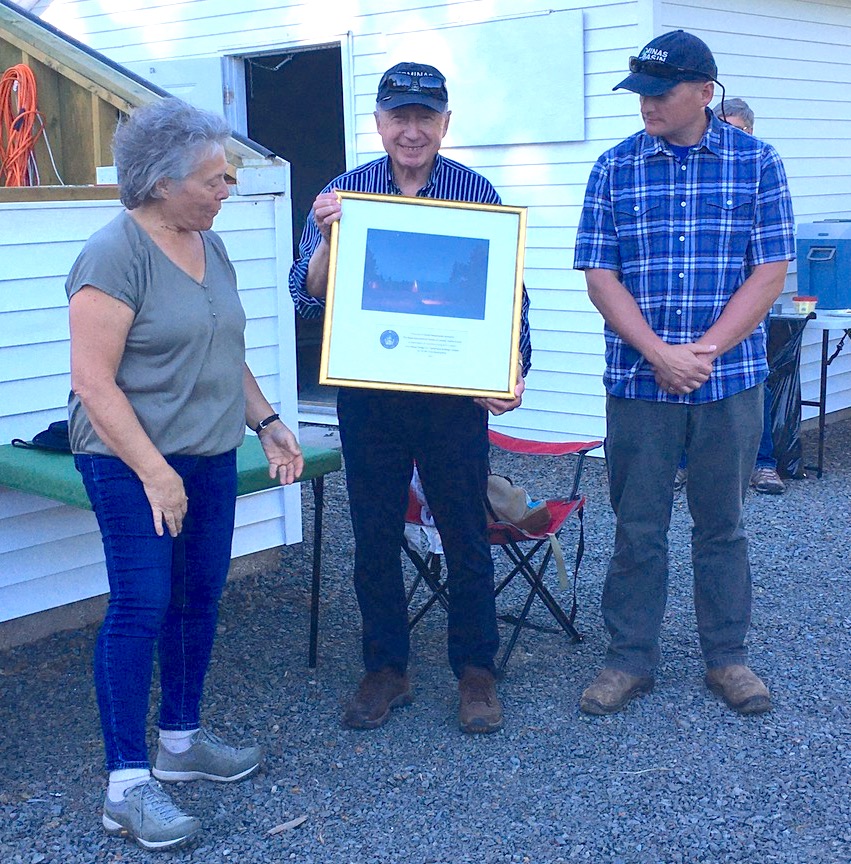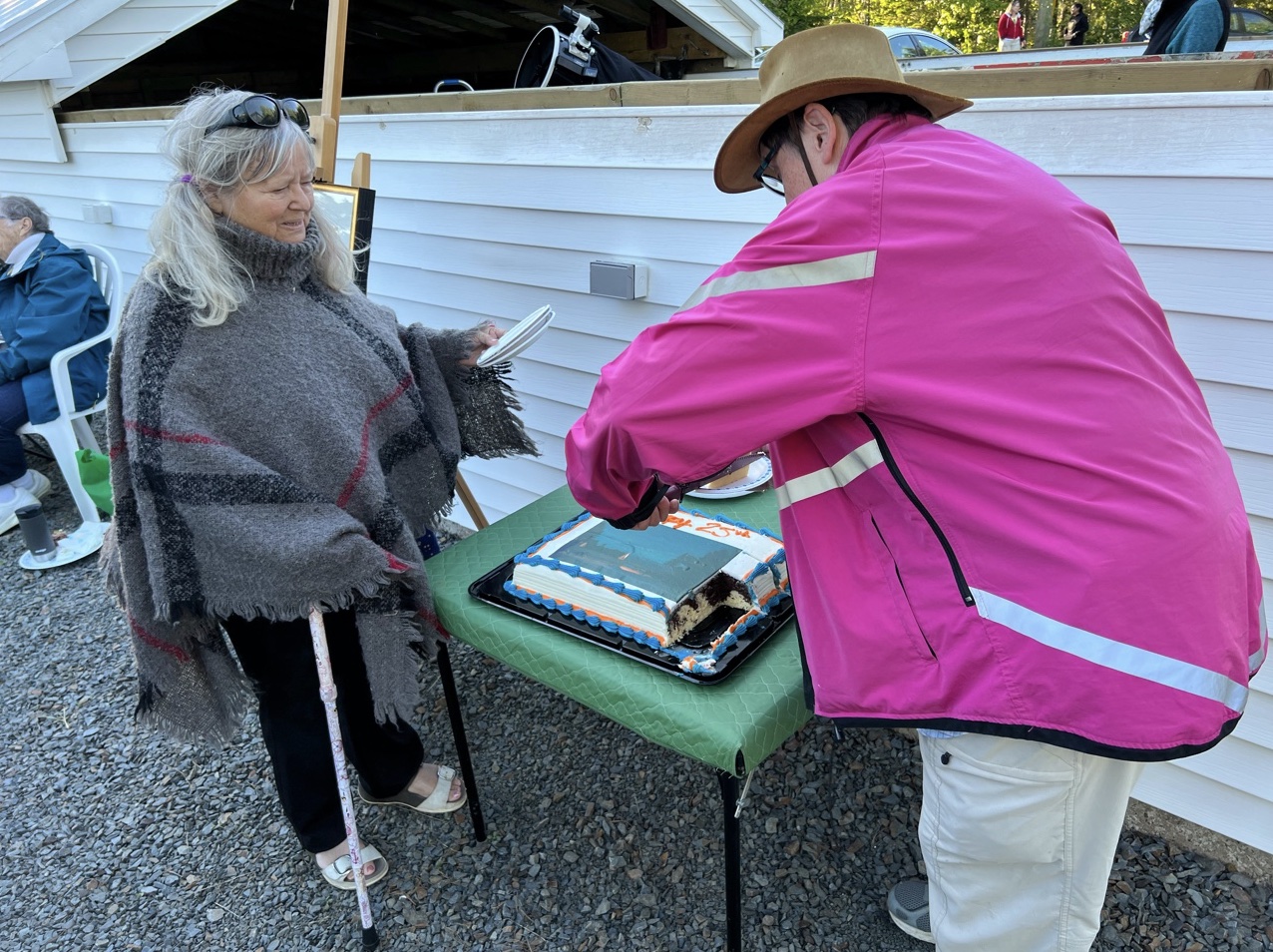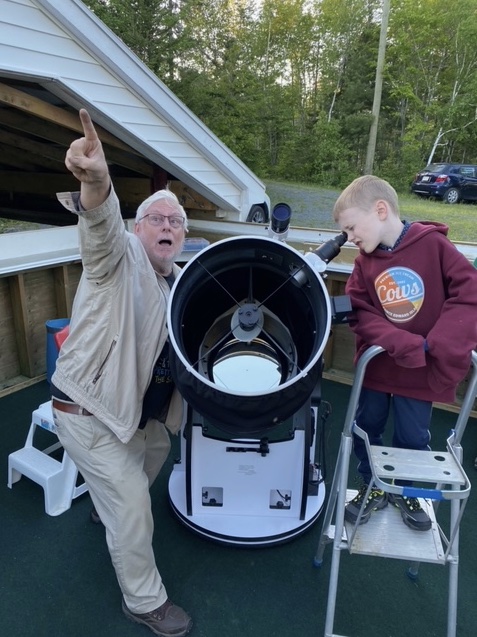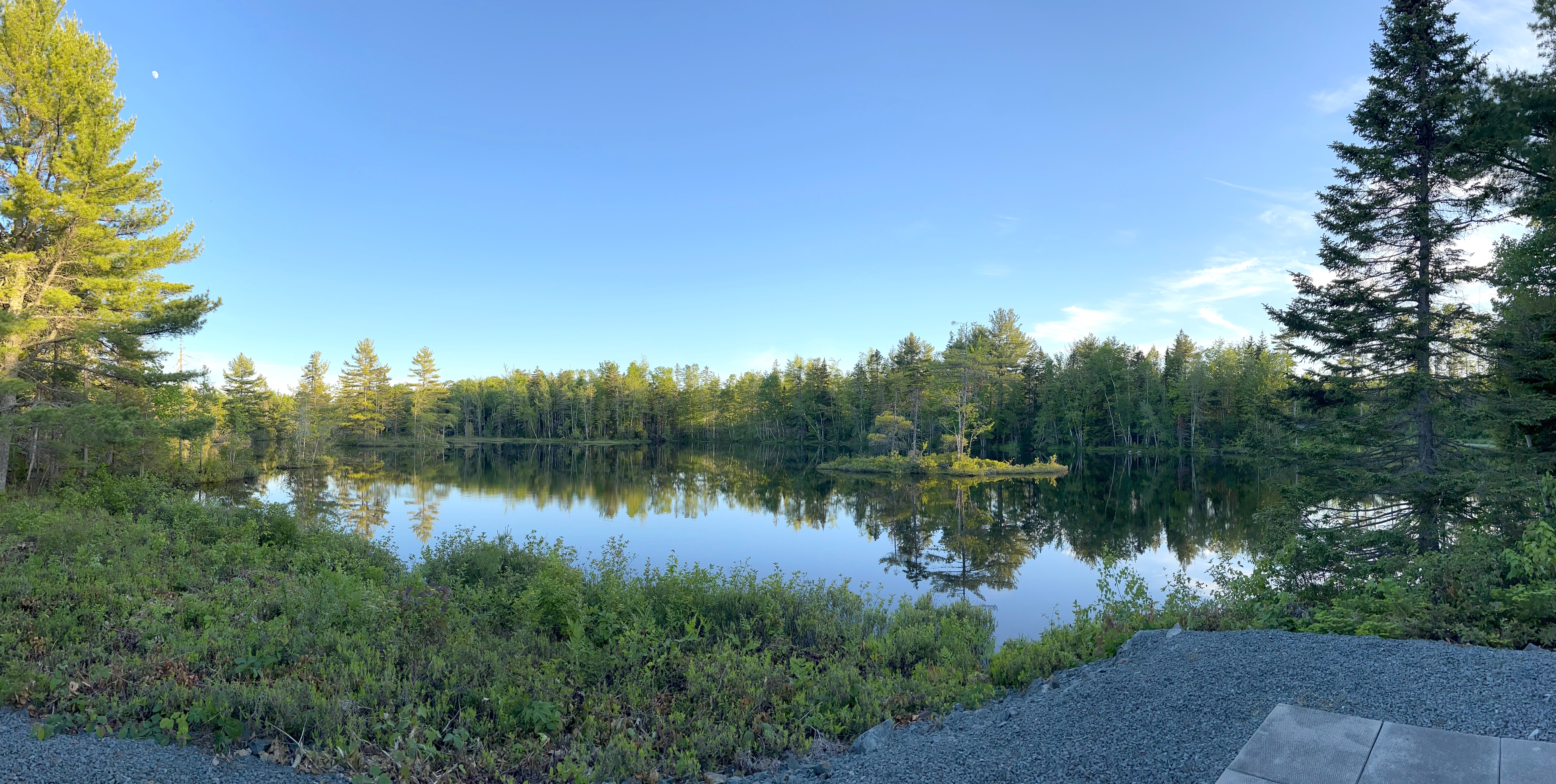Recognition: A special notice or attention
by Roy Bishop and Judy Black
| On Friday, June 10, 2022, at the barbecue at SCO, the RASC Halifax Centre formally recognized the 25th anniversary of SCO’s official opening on June 21, 1997. After welcoming everyone to the barbecue, Judy Black, President, turned the floor over to Roy Bishop who provided a brief summary of the history of SCO and the contributions made by members and especially by Scotia Investments Limited. |
|
A search for an observatory site began in 1993, the same year the Halifax Centre hosted its third national RASC General Assembly. A committee was struck to look at sites north of Chester, but by the autumn of 1994 a site at Courthouse Hill in Gore was being considered. After dark on October 28 that year Centre President Dave Lane, Roy Bishop, Shawna Mitchell, and Clint Shannon visited the Gore site where they encountered a stiff wind, car lights on the road approaching from the north, and a high southern horizon affected by the light dome of Sackville, Halifax and Dartmouth. The second member of this intrepid group proposed that, on the return that night, they should look at a woods road connecting two hydroelectric plants at St. Croix. (The road, two dams, and two hydroelectric generators were constructed in the depth of the Depression, between 1933 and 1938.) Here, only 50 km northwest of Halifax via a four-lane highway, they found no wind, no lights, no traffic, and a low southern horizon with no light pollution. The light dome of Sackville, Halifax and Dartmouth was low in the southeast behind trees, and the light dome from Windsor was similarly hidden low in the northwest. Like Gore, the site was inland away from the coast, therefore had a low chance of fog. Unlike Gore, it was in a slight hollow giving the area considerable protection from wind.
By June 1995 a picturesque, small peninsula surrounded by water on three sides was selected as the best observatory site. Although located in a forest, there were no trees to worry about toward the crucial southern half of the meridian as trees do not grow in water. Recognition of an ideal observing site!
“All” that was left to do was to obtain permission of the owners of the private hydroelectric complex to lease the site for an affordable annual fee, undertake a survey of the site, cut down and remove most of the forest on the peninsula, draw up plans for an observatory and a warm room, obtain building permits from the Municipality of West Hants, raise funds for the building materials, prepare a driveway and a parking lot, construct the buildings, and obtain insurance on the property! It is remarkable that, within the next two years, the RASC Halifax Centre, an unincorporated group of random individuals who had nothing in common but a desire to experience the universe, accomplished those tasks.
Minas Basin Pulp & Power, now better known as Minas Energy, both subsidiaries of Scotia Investments Limited of Bedford, became our landlords in June 1995. Recognition of a great partnership beginning.
Throughout the summer and autumn of 1995, beginning with a site survey, Centre members brought chain saws and cleared much of the forest on the peninsula, making room for a driveway, parking lot, and a south-facing observing area.
The next spring Comet Hyakutake passed by Earth. Several days prior, clouds had allowed the comet to sneak up on observers in Nova Scotia, but on the night of 1996 March 24/25 when Hyakutake was closest to Earth, the clouds parted leaving a transparent sky. From the Halifax area that evening the comet was mostly obscured by light pollution, and the 6-day Moon in the sky did not help. Moonset was just after midnight, so some Centre members made a midnight drive to St. Croix. When they tumbled out of their cars and looked up, the expletives were not fit to print. Directly overhead was the sight of a lifetime. With the core of Hyakutake’s coma resembling a blue-green, negative-one-magnitude welder’s arc, the coma itself larger than the full Moon, and an ion tail spanning more than 40 degrees, the comet sprawled through the zenith from north of the Big Dipper southward into Virgo. The Atlas of Great Comets (Ronald Stoyan, Cambridge University Press, 2015) describes Hyakutake that night: “The almost ominous impression resembled the broadsheets of former centuries: so mighty may the phenomenon of a comet appear.”
The next day Dave Chapman, then President of the Halifax Centre, emailed all he could reach with the plea: “Get outta the city, you owe it to yourself!” Recognition of the value of SCO as a dark observing site!
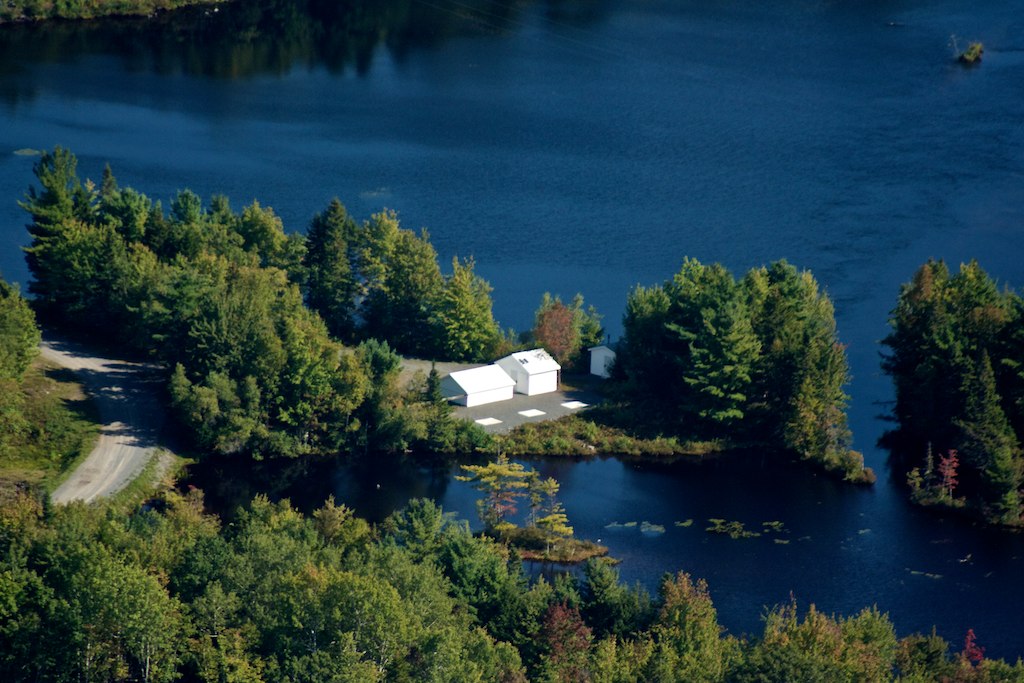 |
During the spring, summer, and autumn of 1996, more trees were removed, a roll-off roof observatory and a warm room designed, building permits obtained, foundations excavated, concrete poured, walls and roofs constructed, rails installed on which to roll the roof of the observatory, vinyl siding applied, and solar cells mounted to charge batteries for 12 V power, leading up to the official opening of St. Croix Observatory on 1997 June 21 at 13:18 ADT, the day of the Summer Solstice, and the moment that year when the Sun was highest in the sky over SCO. |
During the past quarter century notable observations have been recorded at SCO. A photo of the head of Comet Hyakutake taken by Dave Lane from St. Croix near 3 a.m. on 1996 March 25 when Hyakutake was closest to Earth (0.102 au) graces the cover of the RASC’s 1997 Observer’s Handbook. Another was a spectacular Leonid fireball photographed on 2001 November 18 by Barry Burgess of the Halifax Centre. Barry’s photo appears on the cover of the 2003 Observer’s Handbook. Remarkably, a year later, on 2002 November 19 another Leonid meteor, not nearly as spectacular but still rated as a fireball, was photographed at SCO again by Barry Burgess. What made Barry’s 2002 photo particularly special was not realized until several weeks later: Michael Boschat had photographed the same meteor from Halifax! Analysis of the parallax evident in the two photos led to the publication of two papers in the RASC Journal, in the June 2003 and April 2005 editions. In brief, the analysis showed that the length of the meteor’s trail of light was about 43 km, it began at an altitude of 123 km and ended in a burst of light at an altitude of 84 km, 252 km from SCO over the Gulf of Maine, about 40 km south of Yarmouth. Another photo, of the spiral galaxy M33 taken at SCO by Blair MacDonald, appears on the cover of the 2015 Observer’s Handbook.
In 2019 the power line from the upper hydroelectric generator near St. Croix was re-routed to make it more accessible for maintenance, fortuitously bringing it beside the road passing by the driveway into SCO. That led to a significant upgrade to SCO in 2021: connection to 240/120 V, 200 A service thanks to the generosity, expertise and manpower provided by Scotia Investments Limited and a fund-raising campaign by the Halifax Centre to cover the cost of time and materials. SCO is still on solar power (“green” watts) but it is now generated by rainwater spinning a turbine two kilometres upstream from SCO.
At the 25th anniversary barbecue, Roy Bishop particularly noted the contributions of two individuals present that evening. First was John Woods, VP of Energy Development at Minas Energy, who noted that no sooner had the power lines been strung up along the road than Roy Bishop came calling to inquire about electrification of the Observatory. The second was Harden Wile, Jamie Carmichael’s successor as Hydro Manager, responsible for the hydro generator in the Village of St. Croix and the one in the larger of the two dams a few kilometres up the road from SCO. Without these two men and a few other key individuals in Scotia Investments, SCO would not be here. Recognition of the continuing support from Scotia Investments Limited!
|
Judy Black with John Woods and Harden Wile |
The main event of the evening of the 2022 June 10 twenty-fifth anniversary barbecue was the acknowledgement of the past and ongoing support from Scotia Investments Limited for helping to make SCO what it is today. Thirty-five members and guests gathered at St. Croix Observatory for the first time in over two years, a hiatus caused by the Covid-19 pandemic. Young and old alike (ages 7 to 94) enjoyed the sun, the pleasant temperature, the light breeze that kept off the flies, the camaraderie, and good food, including a special 25th anniversary cake! Thank you to John Woods and Harden Wile for contributing to the fun and for accepting our token of recognition for the support over the years. Thank you to Chris Young for assisting with the food planning and acquisition, ‘chef’ John Liddard, Blair MacDonald for the incredible photo taken at SCO for the gift of recognition to Scotia Investments Limited, Mary Lou Whitehorne for her work in acquiring the framed edition of the gift, and to all in attendance for their helping hands in set-up and take-down.
|
It was wonderful to be together for the first time in so long, to catch up with what’s new since we last met, and to recognize the friendships that make our Centre so special. Come visit SCO soon! We would love to hear your voices in the dark.
A closing summary:
With the support of Scotia Investments Limited, the creation of SCO in the mid-1990s was accomplished by several dozen members of the Halifax Centre. Their contributions were many and varied, ranging from moral support and financial contributions to felling trees with chain saws, spreading tonnes of gravel with shovels and rakes, designing a roll-off roof observatory and a warm room, and swinging a hammer. However, five people should be singled out for their dedication and guidance during those years, the Centre presidents: Roy Bishop (1975-76), Mary Lou Whitehorne (1990-91, 2002), Pat Kelly (1992-93), Dave Lane (1994-95), and Dave Chapman (1996-97). All five were present at the 25th anniversary celebration on 2022 June 10.

Panorama of Members & Guests with SCO’s Warm Room, Storage Room and the southern Horizon
 |
 |
| Observatory is open! The gang is here! | |

Harden Wile, Claire Wile, Roy Bishop, Darlene and John Woods |
Post-Presentation: Harden Wile, Roy Bishop, John Woods |
|
SCO Manager John Liddard managing the BBQ |
Honorary President Mary Lou Whitehorne cutting a piece of special cake for Gertrude Bishop. |
|
|
Moon at St. Croix Observatory |


